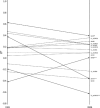Patterns of cyto-nuclear linkage disequilibrium in Silene latifolia: genomic heterogeneity and temporal stability
- PMID: 24002238
- PMCID: PMC3907093
- DOI: 10.1038/hdy.2013.79
Patterns of cyto-nuclear linkage disequilibrium in Silene latifolia: genomic heterogeneity and temporal stability
Abstract
Non-random association of alleles in the nucleus and cytoplasmic organelles, or cyto-nuclear linkage disequilibrium (LD), is both an important component of a number of evolutionary processes and a statistical indicator of others. The evolutionary significance of cyto-nuclear LD will depend on both its magnitude and how stable those associations are through time. Here, we use a longitudinal population genetic data set to explore the magnitude and temporal dynamics of cyto-nuclear disequilibria through time. We genotyped 135 and 170 individuals from 16 and 17 patches of the plant species Silene latifolia in Southwestern VA, sampled in 1993 and 2008, respectively. Individuals were genotyped at 14 highly polymorphic microsatellite markers and a single-nucleotide polymorphism (SNP) in the mitochondrial gene, atp1. Normalized LD (D') between nuclear and cytoplasmic loci varied considerably depending on which nuclear locus was considered (ranging from 0.005-0.632). Four of the 14 cyto-nuclear associations showed a statistically significant shift over approximately seven generations. However, the overall magnitude of this disequilibrium was largely stable over time. The observed origin and stability of cyto-nuclear LD is most likely caused by the slow admixture between anciently diverged lineages within the species' newly invaded range, and the local spatial structure and metapopulation dynamics that are known to structure genetic variation in this system.
Figures

Similar articles
-
Recombination and linkage disequilibrium among mitochondrial genes in structured populations of the gynodioecious plant Silene vulgaris.Evolution. 2008 Apr;62(4):823-32. doi: 10.1111/j.1558-5646.2008.00331.x. Epub 2008 Jan 23. Evolution. 2008. PMID: 18221382
-
Phylogeographic pattern of range expansion provides evidence for cryptic species lineages in Silene nutans in Western Europe.Heredity (Edinb). 2016 Mar;116(3):286-94. doi: 10.1038/hdy.2015.100. Epub 2015 Dec 9. Heredity (Edinb). 2016. PMID: 26647652 Free PMC article.
-
Genetic structure of hybrid zones between Silene latifolia and Silene dioica (Caryophyllaceae): evidence for introgressive hybridization.Mol Ecol. 2007 Jun;16(12):2504-16. doi: 10.1111/j.1365-294X.2007.03292.x. Mol Ecol. 2007. PMID: 17561909
-
[Linkage disequilibrium in plant genomes].Yi Chuan. 2007 Nov;29(11):1317-23. doi: 10.1360/yc-007-1317. Yi Chuan. 2007. PMID: 17989039 Review. Chinese.
-
On selecting markers for association studies: patterns of linkage disequilibrium between two and three diallelic loci.Genet Epidemiol. 2003 Jan;24(1):57-67. doi: 10.1002/gepi.10217. Genet Epidemiol. 2003. PMID: 12508256 Review.
Cited by
-
Chromosome-Level Genome Assembly for the Angiosperm Silene conica.Genome Biol Evol. 2023 Nov 1;15(11):evad192. doi: 10.1093/gbe/evad192. Genome Biol Evol. 2023. PMID: 37862134 Free PMC article.
-
Genetic evidence for multiple sources of the non-native fish Cichlasoma urophthalmus (Günther; Mayan Cichlids) in southern Florida.PLoS One. 2014 Sep 3;9(9):e104173. doi: 10.1371/journal.pone.0104173. eCollection 2014. PLoS One. 2014. PMID: 25184569 Free PMC article.
-
Ancient events and climate adaptive capacity shaped distinct chloroplast genetic structure in the oak lineages.BMC Evol Biol. 2019 Nov 4;19(1):202. doi: 10.1186/s12862-019-1523-z. BMC Evol Biol. 2019. PMID: 31684859 Free PMC article.
-
Mitonuclear linkage disequilibrium in human populations.Proc Biol Sci. 2015 Sep 22;282(1815):20151704. doi: 10.1098/rspb.2015.1704. Proc Biol Sci. 2015. PMID: 26378221 Free PMC article.
-
Altitudinal gradients, biogeographic history and microhabitat adaptation affect fine-scale spatial genetic structure in African and Neotropical populations of an ancient tropical tree species.PLoS One. 2017 Aug 3;12(8):e0182515. doi: 10.1371/journal.pone.0182515. eCollection 2017. PLoS One. 2017. PMID: 28771629 Free PMC article.
References
-
- Abdoullaye D, Acevedo I, Adebayo AA, Behrmann-Godel J, Benjamin RC, Bock DG, et al. Permanent genetic rsources added to Molecular Ecology resources database 1 August 2009-30 September 2009. Mol Ecol Res. 2010;10:232–236. - PubMed
-
- Andras JP, Ebert D. A novel approach to parasite population genetics: experimental infection reveals geographic differentiation, recombination and host-mediated population structure in Pasteuria ramosa, a bacterial parasite of Daphnia. Mol Ecol. 2013;22:972–986. - PubMed
-
- Arnold ML. Evolution Through Genetic Exchange. Oxford University Press: Oxford, UK; 2006.
Publication types
MeSH terms
LinkOut - more resources
Full Text Sources
Other Literature Sources
Research Materials

